Economy of France
| Economy of France | |
|---|---|
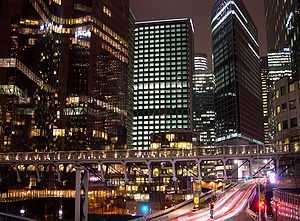 La Défense is a major business district in Europe | |
| Currency | 1 euro (€1) = 100-cent |
| Calendar year | |
Trade organisations | EU, WTO and OECD |
| Statistics | |
| GDP | $2.469 trillion (Nominal; April 2015 est.)[1] |
| GDP rank | 6th (Nominal) / 9th (PPP) |
GDP growth |
|
GDP per capita | Nominal : $41,141 (2012) |
GDP by sector | agriculture (1.9%), industry (18.3%), services (79.8%) (2012 est) |
|
| |
Population below poverty line | 6.2% (2012) |
|
| |
Labour force | +30 million (2015) |
Labour force by occupation | services (71.8%), industry (24.3%), agriculture (3.8%) (2009) |
| Unemployment |
|
Average net salary | €2,157 monthly (2012)[4] |
Main industries | machinery, chemicals, automobiles, metallurgy, aircraft, electronics; textiles, food processing; tourism |
| 34th[5] | |
| External | |
| Exports |
|
Export goods | machinery and equipment, aircraft, plastics, chemicals, pharmaceutical products, iron and steel, beverages |
Main export partners |
|
| Imports |
|
Import goods | machinery and equipment, vehicles, crude oil, aircraft, plastics, chemicals |
Main import partners |
|
FDI stock |
|
Gross external debt |
|
| Public finances | |
|
| |
| Revenues | $1.341 trillion (2012 est.) |
| Expenses | $1.458 trillion (2012 est.) |
| Economic aid | donor: ODA $10.1 billion (2006) |
|
AA (Domestic) AA (Foreign) AAA (T&C Assessment) (Standard & Poor's)[8] | |
Foreign reserves |
|

France has the world's sixth-largest economy by nominal figures and the ninth largest economy by PPP figures.[9] It has the third-largest economy in Europe, in nominal figures, based on the dynamic industrial structure of the French economy.[10] OECD is headquartered in Paris, the nation's financial capital.
- Chemical industry is a key sector for France, helping to develop other manufacturing activities and contributing to economic growth.[11] Tourism in France is the most popular tourist destination in the world.[12][13]
- In 2010, Credit Suisse's Global Wealth Report ranked France the wealthiest European country with 2.6 million dollar-millionaires, and the world's 4th wealthiest[14] nation[15] in aggregate household wealth.
- According to the IMF, in 2013, France is the world's 20th country by GDP per capita with $44,099 per inhabitant.
- In 2010, France was listed 14th on the United Nations's Human Development Index with 0.872 (very high human development) and 25th on the Corruption Perceptions Index.
After the turn of the millennium, wealth per adult grew very strongly in France, tripling in value between 2000 and 2007. France's economy entered the recession of the late 2000s later and appeared to leave it earlier than most comparable economies, only enduring four-quarters of contraction.[16] Between January and March 2011, France's GDP growth had been stronger than expected at 0.9% but shrunk between April and June 2011 decreasing by −0.1%. However, in 2012 growth was stagnant, and in the final quarter of 2013 the French economy was growing at a slow rate of 0.3%.[17]
France's world leading corporations
With 31 of the 500 biggest companies of the world in 2013, France ranks 4th in the Fortune Global 500, behind the USA, China and Japan. Paris is the second most important location in the world for the headquarters of the world's 500 largest companies: there are more Fortune Global 500 company headquarters in Paris than in Beijing, New York, London or Munich, but fewer than in Tokyo.[18]
AXA is one of the world's largest insurance companies; Air France is the world's largest airline company in incomes; L'Oreal is the world's largest cosmetic company; LVMH and PPR are the world's largest and second-largest luxury product companies respectively; GDF-Suez is the world's largest energy company; EDF is the world's largest utility company; Areva is a large nuclear-energy company; Veolia Environnement is the world's largest environmental services and water management company; VINCI, Bouygues and Eiffage are respectively world's 1st, 2nd and 4th building and public work companies; Michelin is the world's pneumatic leader; Lafarge is the world's largest cement company; JCDecaux is the world's largest outdoor advertising corporation; BNP Paribas, Credit Agricole and Societe Generale are respectively the world's 1st, 6th and 8th biggest banks in assets in 2010;[19]
Carrefour is the world's second largest retail group in terms of revenue; Total is the world's fourth largest private oil company; Danone is the world's fifth largest food company and the world's largest supplier of mineral water; Sanofi Aventis is the world's fifth largest pharmaceutical company; Publicis is the world's third largest advertising company; PSA is the world's 6th and Europe's 2nd largest automaker; Renault-Nissan is the world's leading electric car developer among major automakers; Accor is the leading European hotel group; Alstom is one of the world's leading conglomerates in power generation and transport; Pernod Ricard is one of the world's biggest producer of distilled beverages (owning the former Seagram distilleries).
In 2008, France was the second-largest recipient of foreign direct investment among OECD countries at $117.9 billion, above the United Kingdom ($96.9 billion), Germany ($24.9 billion), or Japan ($24.4 billion).[20][21] In the same year, French companies invested $220 billion outside France, ranking France as the second most important outward direct investor in the OECD, behind the United States ($311.8 billion), and ahead of the United Kingdom ($111.4 billion), Japan ($128 billion) and Germany ($156.5 billion).[20][21]
Rise and decline of dirigisme
France embarked on an ambitious and very successful programme of modernization under state coordination. This programme of dirigisme, mostly implemented by governments between 1944 and 1983, involved the state control of certain industries such as transportation, energy and telecommunications as well as various incentives for private corporations to merge or engage in certain projects.
The 1981 election of president François Mitterrand saw a short-lived increase in governmental control of the economy, nationalising many industries and private banks. This form of increased dirigisme, was criticised as early as 1982. By 1983, the government decided to renounce dirigisme and start an era of rigueur ("rigour") or corporatization. As a result the government largely retreated from economic intervention; dirigisme has now essentially receded, though some of its traits remain. The French economy grew and changed under government direction and planning much more than in other European countries.
Despite being a widely liberalized economy, the government continues to play a significant role in the economy: government spending, at 56% of GDP in 2014, is the second highest in the European Union. Labour conditions and wages are highly regulated. The government continues to own shares in corporations in a range of sectors, including banking, energy production and distribution, automobiles, transportation, and telecommunications. These differ from countries such as the US or UK where most of these companies have been privatized.
Government finance
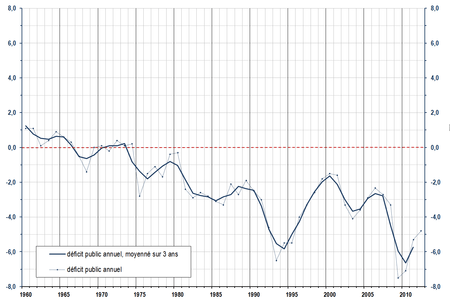
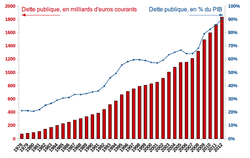
In April and May 2012, France held a presidential election in which the winner François Hollande had opposed austerity measures, promising to eliminate France's budget deficit by 2017. The new government stated that it aimed to cancel recently enacted tax cuts and exemptions for the wealthy, raising the top tax bracket rate to 75% on incomes over a million euros, restoring the retirement age to 60 with a full pension for those who have worked 42 years, restoring 60,000 jobs recently cut from public education, regulating rent increases; and building additional public housing for the poor.
In June, Hollande's Socialist Party won a supermajority in legislative elections capable of amending the French Constitution and enabling the immediate enactment of the promised reforms. French government bond interest rates fell 30% to record lows,[22] less than 50 basis points above German government bond rates.[23]
French government debt
The French government has run a budget deficit each year since the early 1970s. In mid-2012, French government debt levels reached €1,833 billion.[24] This debt level was the equivalent of 91% of French GDP.[24]
Under European Union rules, member states are supposed to limit their debt to 60% of output or be reducing the ratio structurally towards this ceiling, and run public deficits of no more than 3.0% of GDP.[24]
In late 2012, credit-rating agencies warned that growing French government debt levels risked France's AAA credit rating, raising the possibility of a future credit downgrade and subsequent higher borrowing costs for the French government.[25]
In 2012 France was downgraded by ratings agencies Moody's, Standard&Poor's, and Fitch to the AA+ credit rating.[26][27]
In December 2014 France's credit rating was further downgraded by Fitch (and S&P) to the AA credit rating.[28]
Sectors of the economy
Industry
2006 electricity production of France
The leading industrial sectors in France are telecommunications (including communication satellites), aerospace and defense, ship building (naval and specialist ships), pharmaceuticals, construction and civil engineering, chemicals, textiles, and automobile production.
Research and development spending is also high in France at 2.26% of GDP, the fourth-highest in the OECD.[29]
Energy
France is the world-leading country in nuclear energy, home of global energy giants Areva, EDF and GDF Suez: nuclear power now accounts for about 78% of the country's electricity production, up from only 8% in 1973, 24% in 1980, and 75% in 1990. Nuclear waste is stored on site at reprocessing facilities. Due to its heavy investment in nuclear power, France is the smallest emitter of carbon dioxide among the seven most industrialized countries in the world.[30]
In 2006 electricity generated in France amounted to 548.8 TWh, of which:[31]
- 428.7 TWh (78.1%) were produced by nuclear power generation
- 60.9 TWh (11.1%) were produced by hydroelectric power generation
- 52.4 TWh (9.5%) were produced by fossil-fuel power generation
- 21.6 TWh (3.9%) by coal power
- 20.9 TWh (3.8%) by natural-gas power
- 9.9 TWh (1.8%) by other fossil fuel generation (fuel oil and gases by-products of industry such as blast furnace gases)
- 6.9 TWh (1.3%) were produced by other types of power generation (essentially waste-to-energy and wind turbines)
- The electricity produced by wind turbines increased from 0.596 TWh in 2004, to 0.963 TWh in 2005, and 2.15 TWh in 2006, but this still accounts only for 0.4% of the total production of electricity (as of 2006).
In November 2004, EDF (which stands for Electricité de France), the world's largest utility company and France's largest electricity provider, was floated with huge success on the French stock market. Notwistanding, the French state still keeps 70% of the capital.
Other electricity providers include Compagnie nationale du Rhône (CNR) and Endesa (through SNET).
Agriculture
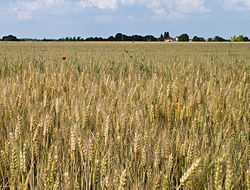
France is the world's sixth-largest agricultural producer and EU's leading agricultural power, accounting for about one-third of all agricultural land within the EU.
Northern France is characterized by large wheat farms. Dairy products, pork, poultry, and apple production are concentrated in the western region. Beef production is located in central France, while the production of fruits, vegetables, and wine ranges from central to southern France. France is a large producer of many agricultural products and is currently expanding its forestry and fishery industries. The implementation of the Common Agricultural Policy (CAP) and the Uruguay Round of the General Agreement on Tariffs and Trade (GATT) have resulted in reforms in the agricultural sector of the economy.
As the world's second-largest agricultural exporter, France ranks just after the United States.[32] The destination of 49% of its exports are other EU members states. France also provide agricultural exports to many poor African countries (including its former colonies) which face serious food shortage. Wheat, beef, pork, poultry, and dairy products are the principal exports.
Exports from the United States face stiff competition from domestic production, other EU member states, and third world countries in France. US agricultural exports to France, totaling some $600 million annually, consist primarily of soybeans and soybean products, feeds and fodders, seafood, and consumer products, especially snack foods and nuts. French exports to the United States are much more high-value products such as its cheese, processed products and its wine.
The French agricultural sector received almost €11 billion in EU subsidies. France's competitive advantage is mostly linked to the high quality and global reputation of its products, among which are some of the world's most renowned agricultural products such as wine and cheese. Such world-famous products goes a long way to create a thriving domestic sector.
Tourism
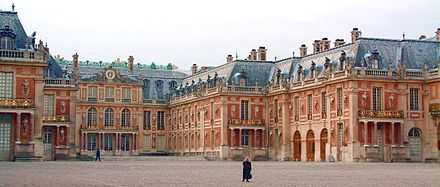
France is a popular tourist destination with more than 81.9 million foreign tourists in 2007,[33] ahead of Spain (58.5 million in 2006) and the United States (51.1 million in 2006). This figure excludes people staying less than 24 hours in France, such as northern Europeans crossing France on their way to Spain or Italy during the summer.
France is home to cities of much cultural interest (Paris being the foremost), beaches and seaside resorts, ski resorts, and rural regions that many enjoy for their beauty and tranquillity. France also attracts many religious pilgrims to Lourdes, a town in the Hautes-Pyrénées département, which hosts several million visitors a year.
According to figures from 2003, some popular tourist sites include (in visitors per year):[34] Eiffel Tower (6.2 million), Louvre Museum (5.7 million), Palace of Versailles (2.8 million), Musée d'Orsay (2.1 million), Arc de Triomphe (1.2 million), Centre Pompidou (1.2 million), Mont-Saint-Michel (1 million), Château de Chambord (711,000), Sainte-Chapelle (683,000), Château du Haut-Kœnigsbourg (549,000), Puy de Dôme (500,000), Musée Picasso (441,000), Carcassonne (362,000).
Weapons industry
The French arms industry's main customer, for whom they mainly build warships, guns, nuclear weapons and equipment, is the French Government.
Record high defence expenditure (currently at €35 billion), which was considerably increased under the government of Prime Minister Jean-Pierre Raffarin, goes largely to the French arms industries.
France is also the fourth largest weapons exporter in the world.[35]
French manufacturers export great quantities of weaponry to the United Arab Emirates, Brazil, Greece, India, Pakistan, Taiwan, Singapore and many others.
External trade
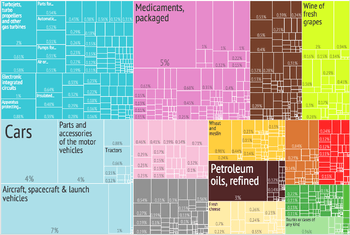
France is the second-largest trading nation in Europe (after Germany).[36] Its foreign trade balance for goods had been in surplus from 1992 until 2001, reaching $25.4 billion (25.4 G$) in 1998; however, the French balance of trade was hit by the economic downturn, and went into the red in 2000, reaching a US$15bn deficit in 2003. Total trade for 1998 amounted to $730 billion, or 50% of GDP—imports plus exports of goods and services. Trade with European Union countries accounts for 60% of French trade.
In 1998, US–France trade stood at about $47 billion – goods only. According to French trade data, US exports accounted for 8.7% – about $25 billion – of France's total imports. US industrial chemicals, aircraft and engines, electronic components, telecommunications, computer software, computers and peripherals, analytical and scientific instrumentation, medical instruments and supplies, broadcasting equipment, and programming and franchising are particularly attractive to French importers.
The principal French exports to the US are aircraft and engines, beverages, electrical equipment, chemicals, cosmetics, luxury products and perfume. France is the ninth-largest trading partner of the US.
Régions economy

The economic disparity between French regions is not as high as that in other European countries such as the UK, Italy or Germany, and higher than in countries like Sweden or Denmark, or even Spain. However, Europe's wealthiest and second largest regional economy, Ile-de-France (the region surrounding Paris), has long profited from the capital city's economic hegemony.
The most important régions are Ile-de-France (world's 4th and Europe 2nd wealthiest and largest regional economy), Rhône-Alpes (Europe's 5th largest regional economy thanks to its services, high-technologies, chemical industries, wines, tourism), Provence-Alpes-Côte d'Azur (services, industry, tourism and wines), Nord-Pas-de-Calais (European transport hub, services, industries) and Pays de la Loire (green technologies, tourism).
Régions like Alsace, which has a rich past in industry (machine tool) and currently stands as a high income service-specialized region, are very wealthy without ranking very high in absolute terms.
The rural areas are mainly in Auvergne, Limousin, and Centre, and wine production accounts for a significant proportion of the economy in Aquitaine (Bordeaux (or claret)), Burgundy, and champagne produced in Champagne-Ardennes.

List of French régions ranked by GDP total and per capita.
| Rank | Region | GDP (in millions euros, 2009) | GDP per capita (euros, 2009) | GDP (in millions US Dollars, 2009) | GDP per capita (US Dollars, 2009) |
|---|---|---|---|---|---|
| 1 | Île-de-France | 552,052 | 51,101 | 769,705 | 69,973 |
| 2 | Rhône-Alpes | 181,810 | 29,420 | 253,491 | 41,019 |
| 3 | Provence-Alpes-Côte d'Azur | 138,002 | 27,855 | 192,411 | 38,837 |
| 4 | Nord-Pas de Calais | 96,839 | 24,025 | 135,019 | 33,497 |
| 5 | Pays de la Loire | 94,032 | 26,481 | 131,105 | 36,921 |
| 6 | Aquitaine | 85,693 | 26,710 | 119,478 | 37,241 |
| 7 | Brittany | 81,632 | 25,739 | 113,816 | 35,887 |
| 8 | Midi-Pyrénées | 76,522 | 26,628 | 106,692 | 37,126 |
| 9 | Centre | 65,173 | 25,571 | 90,868 | 35,653 |
| 10 | Languedoc-Roussillon | 60,523 | 22,984 | 84,385 | 32,046 |
| 11 | Lorraine | 55,396 | 23,653 | 77,237 | 32,978 |
| 12 | Alsace | 50,701 | 27,322 | 70,690 | 38,094 |
| 13 | Upper Normandy | 48,555 | 26,599 | 67,698 | 37,086 |
| 14 | Picardy | 43,725 | 22,894 | 60,964 | 31,920 |
| 15 | Poitou-Charentes | 42,379 | 24,046 | 59,087 | 33,526 |
| 16 | Burgundy | 41,805 | 25,516 | 58,287 | 35,576 |
| 17 | Champagne-Ardenne | 35,779 | 26,768 | 49,885 | 37,322 |
| 18 | Lower Normandy | 34,869 | 23,737 | 48,617 | 33,096 |
| 19 | Auvergne | 33,174 | 24,680 | 46,253 | 34,410 |
| 20 | Franche-Comté | 28,083 | 24,042 | 39,155 | 33,521 |
| 21 | Limousin | 17,509 | 23,637 | 24,412 | 32,956 |
| 22 | Corsica | 7,279 | 23,800 | 10,149 | 33,183 |
Source : INSEE. Source : fxtop.com.
Departements economy and cities

Departemental income inequalities
In terms of income, important inequalities can be observed among the French départements.
According to the 2008 statistics of the INSEE, the Yvelines is the highest income département of the country with an average income of €4,750 per month. Hauts-de-Seine comes second, Essonne third, Paris fourth, Seine-et Marne fifth.
Ile-de-France is the wealthiest region in the country with an average income of €4,228 per month (and is also the wealthiest region in Europe) compared to €3,081 at the national level. Alsace comes second, Rhône-Alpes third, Picardy fourth, and Upper Normandy fifth.
The poorest parts of France are the French overseas départements, French Guiana being the poorest département with an average household income of €1,826. In metropolitan France it is Creuse in the Limousin region which comes bottom of the list with an average household income of €1,849 per month.[37]
Urban income inequalities
Huge inequalities can also be found among cities. In the Paris metropolitan area, significant differences exist between the higher standard of living of Paris Ouest and lower standard of living in areas in the northern banlieues of Paris such as Seine-Saint-Denis.
For cities of over 50,000 inhabitants, Neuilly-sur-Seine, a western suburb of Paris, is the wealthiest city in France with an average household income of €5,939, and 35% earning more than €8,000 per month.[38] But within Paris, four arrondissements surpass wealthy Neuilly-sur-Seine in household income: the 6th, the 7th, the 8th and the 16th; the 8th "arrondissement" being the wealthiest district in France (the other three following it closely as 2nd, 3rd and 4th wealthiest ones).
Wealth
Overview
In 2010, the French had an estimated wealth of US$14.0 trillion for a population of 63 million.[39]
- In terms of aggregate wealth, the French are the wealthiest Europeans, accounting for more than a quarter of wealthiest European households.[40] Globally, the French nation ranks fourth-wealthiest,.[41][42]
- In 2010, wealth per French adult was a little higher than $290,000, down from a pre-crisis high of $300,000 in 2007. According to this ratio, French are the wealthiest in Europe. The tax on wealth is paid by 1.1M of people in France, the payment of this tax starts when a €1.3M of assets is reached (there is a discount on the principal residence value).
- Almost every French household has at least $1,000 in assets.[43] Proportionally, there are twice as many French with assets of over $10,000 and four times as many French with assets of over $100,000 than the world average.[44]
- The French are also among the least indebted populations in the developed world with personal debt accounting for "little more than 10% of household assets".[45]
Millionaires
France has the highest number of millionaires in Europe. There were 2.6 million millionaire households (measured in terms of US dollars) living in France in 2010 followed by the UK (1.2M) and Germany (880,000). (Crédit Suisse Global wealth report). This accounts for about 3.9% of the total French population.
In 2010, among the top 1% of global wealth holders, 4,045 are French.
The wealthiest European is the French multibillionaire and LVMH CEO and owner Bernard Arnault.[46] The world's third wealthiest woman is French L'Oreal cosmetic empire heiress Liliane Bettencourt.
See also
General:
Notes and references
- ↑ IMF April,2015
- ↑ Parussini, Gabriel (20 February 2014). "Feb. 20, 2014, 3:38 a.m. EST French consumer rices post record fall in January". The Wall Street Journal. Retrieved 22 February 2014.
- ↑ "Taux de chômage et chômeurs en France : où en est-on en décembre 2013?". journaldunet.com. JDN. 20 December 2013. Retrieved 21 December 2013.
- ↑ "Wages and Taxes for the Average Joe in the EU 2" (PDF). Retrieved 27 November 2012.
- ↑ "Doing Business in France 2013". World Bank. Retrieved 22 October 2012.
- ↑ "Export Partners of France". CIA World Factbook. 2012. Retrieved 23 July 2013.
- ↑ "Import Partners of France". CIA World Factbook. 2012. Retrieved 23 July 2013.
- ↑ "Sovereigns rating list". Standard & Poor's. Retrieved 12 March 2015.
- ↑ "Gross domestic product 2008" (PDF). World Bank. Retrieved 1 March 2010.
- ↑ http://www.imf.org/external/pubs/ft/wp/2007/wp07129.pdf
- ↑ http://www.invest-in-france.org/Medias/Publications/227/Chemical%20Industry.pdf
- ↑ http://ec.europa.eu/enterprise/sectors/tourism/tourism-business-portal/documents/business/internationalisation/france_country_report.pdf
- ↑ http://dtxtq4w60xqpw.cloudfront.net/sites/all/files/pdf/unwto_highlights14_en_hr_0.pdf
- ↑ 2010 Global ranking in household wealth: USA (1st), Japan (2nd), China (3rd), France (4th), Germany (5th). Sources: 2010 Credit Suisse Global Wealth Report (see below)
- ↑ Credit Suisse 2010's Global Wealth Report "In euro and USD terms, the total wealth of French households is very sizeable. Although it has just 1.1% of the world’s adults, France ranks fourth among nations in aggregate household wealth – behind China and just ahead of Germany. Europe as a whole accounts for 35% of the individuals in the global top 1%, but France itself contributes a quarter of the European contingent."
- ↑ "Germany, France pull out of recession". CNN. 13 August 2009.
- ↑ "European Economy: How French and German States Compare". BBC. 14 February. Check date values in:
|date=(help) - ↑ Global 500 by Country – Fortune
- ↑ "The 10 Largest Banks in the World". Doughroller.net. Retrieved 27 November 2012.
- ↑ 20.0 20.1 "Country fact sheet: France" (PDF). World Investment Report 2009. UNCTAD. Retrieved 7 October 2010.
- ↑ 21.0 21.1 "Country fact sheet: Japan" (PDF). World Investment Report 2009. UNCTAD. Retrieved 7 October 2010.
- ↑ Bloomberg (2012) French government bond interest rates (graph)
- ↑ Bloomberg (2012) German government bond interest rates (graph)
- ↑ 24.0 24.1 24.2 "French debt jumps, minister promises to meet deficit target". FRANCE 24. 28 September 2012. Retrieved 27 November 2012.
- ↑ John, Mark. "Analysis: Low French borrowing costs risk negative reappraisal". Reuters. Retrieved 27 November 2012.
- ↑ http://www.bbc.co.uk/news/business-16552623
- ↑ http://www.bloomberg.com/news/2013-07-12/france-loses-top-credit-rating-as-fitch-cites-lack-of-growth.html
- ↑ Deenpattern dots, Mark (12 December 2014). "France’s Credit Rating Cut by Fitch to ‘AA’; Outlook Stable". Bloomberg.com. Bloomberg. Retrieved 12 March 2015.
- ↑ "France in the United States: Economy". Embassy of France in Washington. Retrieved 23 April 2010.
- ↑ "Environmental Indicators: Greenhouse Gas Emissions". United Nations. August 2009.
- ↑ Source: L’Electricité en France en 2006 : une analyse statistique
- ↑ (French) L'Agriculture en chiffres
- ↑ "Le tourisme international en France en 2007" (PDF) (in French). Direction du Tourisme (French government's tourism agency). Retrieved 5 June 2008.
- ↑ "Musées et Monuments historiques".
- ↑ SIPRI Arms Transfers Database, data 2000–10. Stockholm International Peace Research Institute
- ↑ "Leading exporters and importers in world merchandise trade, 2007". World Trade Organization. Retrieved 3 June 2009.
- ↑
- ↑ "Salaire moyen Neuilly-sur-Seine – 92200 (60501 habitants) : 4649 euros / mois par ménage – Tout savoir sur revenu moyen, salaire net, salaire brut et retraite par ville de France". Salairemoyen.com. Retrieved 27 November 2012.
- ↑ Credit Suisse 2010's Global Wealth Report p32
- ↑ "Europe as a whole accounts for 35% of the individuals in the global top 1% (of wealthiest households), but France itself contributes a quarter of the European contingent." 2010's Global Wealth Report
- ↑ Rankings: 1st: USA with $54.6 trillion for 318 million inhabitants; 2nd: Japan with $21 trillion for 127 million inhabitants; 3rd: China with $16.5 trillion for 1.331 billion inhabitants; 4th: France with $14.0 trillion for 63 million inhabitants
- ↑ " Although it has just 1.1% of the world’s adults, France ranks fourth among nations in aggregate household wealth – behind China and just ahead of Germany" 2010's Global Wealth Report
- ↑ 2010's Global Wealth Report, p32: Very few households in France are recorded as having less than US$1000 per adult
- ↑ 2010's Global Wealth Report, p32: The proportion with assets over $10,000 is double the world average, and the proportion with more than $100,000 is four times the global figure
- ↑ (2010's Global Wealth Report)
- ↑ "Forbes 2010 Rankings". Forbes.com. 12 February 2010. Retrieved 27 November 2012.
External links
- Official French exporters directory – Firmafrance.com is the Official French exporters B2B directory, powered by Ubifrance and officially endorsed by the Ministry of the Economy, Finance and Industry of France.
- OECD's France country Web site and OECD Economic Survey of France
- French National Institute for Statistics and Economic Studies (INSEE)
- France’s economy and economic policies, on the International Monetary Fund’s (IMF) website
- France’s foreign trade and place in international investment flows, on the French Treasury’s website
- Xerfi ( Xerfi) – French private economic report institute
- Comprehensive current and historical economic data
- World Bank Trade Summary Statistics France 2012
- Useful information about banks in France, including branches and ATMs locations, contacts and SWIFT codes
- Tariffs applied by France as provided by ITC's Market Access Map, an online database of customs tariffs and market requirements.
- International Trade Statistics - France (2014)
| ||||||||||||||||||||||||||||||||||||||||||||
| ||||||||||
| ||||||||||||||||||
| ||||||||||||||||||||
